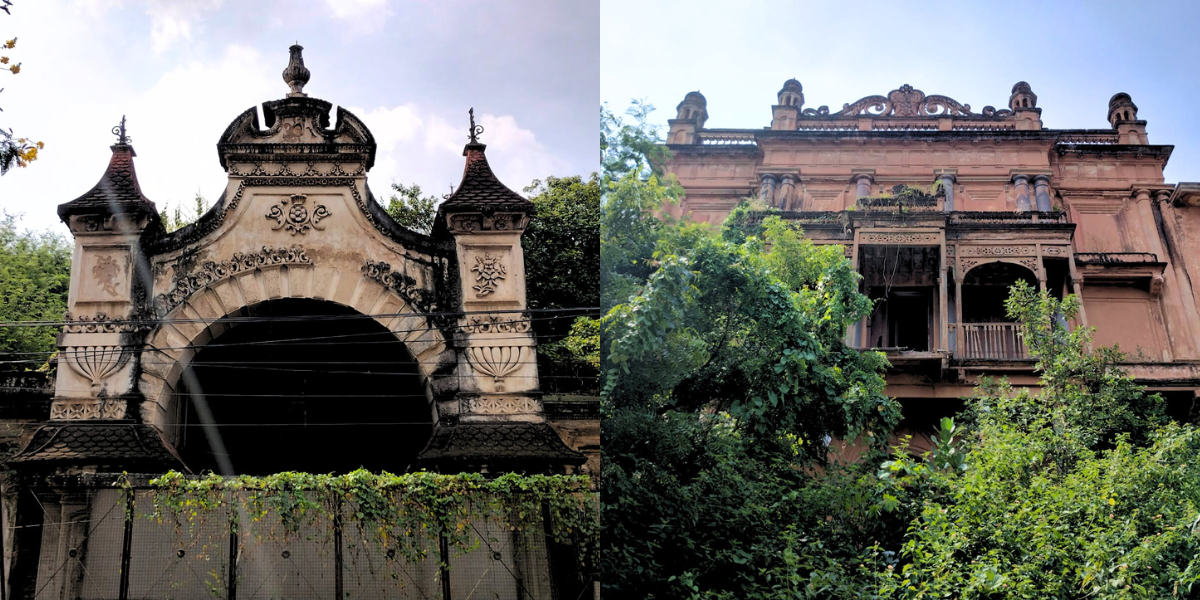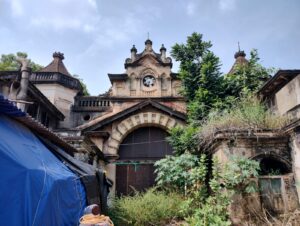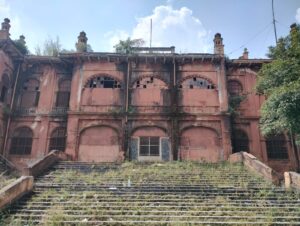Nizam-era King Kothi Palace and Erram Manzil in Hyderabad are in disrepair, and locals want authorities to restore and maintain them.
Published Oct 27, 2024 | 12:00 PM ⚊ Updated Oct 27, 2024 | 3:48 PM

Hyderabad's Nizam-era King Kothi and Erram Manzil are left forgotten as the city develops.
The Abids Road in Hyderabad connects the old with the new, the modern city — shiny and radiant — contrasting with the fraying memories of a royal past.
At an unassuming chaurastha (junction) on Abids Road stands the King Kothi Palace, its vestiges reflecting years of neglect. The outer wall, with the plastering peeled off at several places, has become fertile for moss, and the overgrown vegetation surrounding the structure testimonies the relegation of a once seat of power.
A horizontal iron gate partially hiding the portcullis-like greying entrance gives the impression of a Kafkaesque castle, beyond which time seemingly stands still in mustiness. The reliefs on the wall brave the elements, attracting glances to an otherwise dilapidating structure, once the residence of the Nizam’s servants.
The palace initially belonged to the noble, Kamal Khan, who engraved his custom-made furniture with his initials ‘KK’. Mahmood Ali Pasha, the sixth Nizam, later bought it and reinterpreted the bold engravings to mean King Kothi (palace).

The clock on the eastern side of King Kothi.
Mir Osman Ali Khan, the seventh and last Nizam of Hyderabad, made it his official residence, unlike his father who stayed at the Chowmahalla Palace. It remained his residence even after he lost his status as the Nizam in 1948 until he died in 1967.
“My father, Khaja Iftehar Ahmed, was the peon at the Sarf-e-Khaz and later the Nizam Trust,” Khaja Maqbool Ahmed, one of the 10-odd families still residing next to the palace, said.
“As a child, I used to play hide-and-seek with about seven other kids in King Kothi,” he reminisced, adding people lived in the mahal till 20 years ago. He added that the Nizam had allowed the servants to reside in King Kothi, in seven rooms constructed next to the palace.
“About 20 families were living inside, and soon everybody outside started drawing power and water from the complex. I believe the bill used to run into the lakhs. No wonder, they asked the families inside the complex to vacate,” he said.
He added that at a certain point, the seven rooms had multiplied into 36 before the NT Rama Rao regime took it down in the 1980s.
“We got water and power connection about 20 years ago. However, there is still no guarantee about our housing. We haven’t paid a dime in rent. So, if they ask us to leave tomorrow, it is what it is,” he sighed.
Interestingly, Maqbool’s family has lived there for three generations, like most other families.
Abdul Aziz is a 28-year-old unemployed youth who shares a similar affection for King Kothi. “I was born here and grew up around King Kothi. I played here with my friends and often used to fall asleep in the cool breeze,” he recounted.
He wanted the government to restore the mahal. “K Chandrashekar Rao said he transformed it into a museum, but nothing happened. A monument as good as this needs to be restored,” he opined.
However, Maqbool differed with the youngster. Despite acknowledging that such historical monuments were a part of the city’s soul and identity, he felt it to be a part of the history that not many would remember.
“It would be better if the government restored and maintained the Mahal as a commercial complex, making it useful,” he suggested.
Located 5.8 km away, the Errum Manzil is another abandoned Nizam-era monument.

Erram Manzil.
Standing opposite the government office of the Chief Engineer of the Department of Roads, the walls are peeling off as shrubbery lays claim to the building.
In 2019, the government had planned to raze the structure. Following the pleas of Nawab Shafath Ali Khan, the Secretary of the Nawab Fakhrul Mulk Legal Heirs Association, the High Court ordered the state to stop demolishing the palace.
Soon after, it became a hotspot for cinema shootings, attracting crews from the South Indian industries. However, even this minor surge in popularity could not save the building from ruin.
“If there is no maintenance, the building will eventually crumble,” Yunus Lasania, a journalist-cum-oral historian explained.
Calling the structure built in the 1820s by Nawab Fakhrul Mulk magnificent, he wished for better maintenance of the structure. “To my knowledge, there’s been no maintenance work in many years at both locations,” he recalled.
According to Section 29 of the Hyderabad Metropolitan Development Authority (HMDA) Act, 2008, HMDA shall draw up a plan to conserve and protect heritage sites citywide.
As per the Hyderabad Urban Development Authority (HUDA), one of the constituents of the HMDA, both Errum Manzil and King Kothi are heritage sites.
However, neither structure has seen any development work in the past couple of years. While Errum Manzil lies rotting in front of the Roads and Buildings Department office, it is also being used as a storeroom for the government.
Notably, there is a dishevelled door spelling ‘Seized Goods Storage’ towards the back of the palace.
Erram Manzil is functional to some degree, with its surroundings being used as parking spaces. However, King Kothi does not share the same fate. In 1980, a part of the palace, Usman Mansion, was demolished to build a hospital.
Soon after, King Kothi was embroiled in a legal dispute. After Nizam’s death, the palace went to the Nazri Bagh Trust, which subsequently sold it to the Mumbai-based Neeharika Infrastructure in 2022, which intended to demolish it.
However, Kashmir-based Iris Hospitality has contended ownership of the palace in the Telangana High Court, claiming to have bought it from Neeharika infrastructure.
With both structures withering away with time, it remains to be seen whether their revival is a possibility or if they’ll eventually be relegated to the annals of forgotten history — perhaps until a curious future student goes in search of the past.
(Edited by Majnu Babu).
